This site is supported by our readers. We may earn a commission, at no cost to you, if you purchase through links.
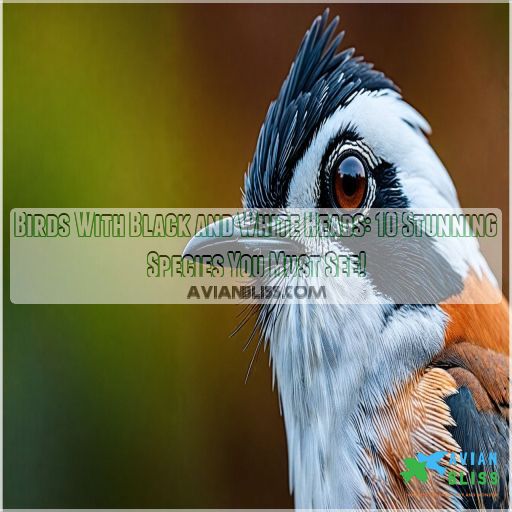
The Black-capped Chickadee, with its distinctive cap and bib, is a cheerful visitor to feeders.
White-crowned Sparrows sport elegant striped crowns, while Mountain Chickadees rock a unique white eyebrow.
Don’t forget woodpeckers like the Downy, with its bold checkered pattern.
These feathered friends aren’t just pretty faces – they’re master survivalists.
Black-capped Chickadees can lower their body temperature to survive frigid nights, and White-crowned Sparrows migrate up to 2,600 miles!
As you explore this avian world, you’ll discover fascinating behaviors that’ll make you see these birds in a whole new light.
Table Of Contents
- Key Takeaways
- Common Black and White Headed Bird Species
- Identifying Features of Black and White Headed Birds
- Woodpeckers With Black and White Head Patterns
- Habitat and Distribution of Black-White Headed Birds
- Warblers Sporting Black and White Head Markings
- Unique Behaviors of Black and White Headed Birds
- Seasonal Changes in Black-White Head Plumage Patterns
- Diet and Feeding Habits of These Birds
- Conservation Status of Black-White Headed Bird Species
- Attracting Black and White Headed Birds to Gardens
- Frequently Asked Questions (FAQs)
- What bird has a white head?
- What birds have black and white coloration?
- What does a blackpoll bird look like?
- What does a black and white bird look like?
- What kind of bird has a black and white head?
- What does it mean when you see a White-crowned Sparrow?
- How rare is a White-crowned Sparrow?
- What is a sparrow looking bird with a black and white head?
- How do black and white head patterns aid in camouflage?
- Do black and white headed birds have any unique vocalizations?
- Are there any black and white headed seabirds?
- How do these birds head patterns affect mating rituals?
- What role do black and white headed birds play in ecosystems?
- Conclusion
Key Takeaways
- You’ll find a diverse array of birds with black and white heads, from the cheerful Black-capped Chickadee to the elegant White-crowned Sparrow, each with unique adaptations for survival.
- These birds’ striking patterns serve multiple purposes, including camouflage, mate attraction, and species identification, showcasing nature’s ingenuity in design.
- You can attract these feathered friends to your garden by providing the right food, water, and shelter, creating a mini-ecosystem right in your backyard.
- By understanding these birds’ behaviors, habitats, and conservation needs, you’re not just birdwatching – you’re connecting with and supporting vital members of our ecosystems.
Common Black and White Headed Bird Species
You’ll find several common birds sporting stylish black and white head patterns, particularly among species of black birds that play a vital role in ecosystems by controlling insect populations, scavenging for food, and spreading seeds, for more information on types of black birds. You’ll find several common birds sporting stylish black and white head patterns, including the adorable Black-capped Chickadee and the distinctive White-crowned Sparrow.
These feathered friends are easy to spot in forests, parks, and even your backyard.
Making birdwatching a fun and accessible hobby for nature enthusiasts of all ages.
Black-capped Chickadee
You’ll fall head over heels for the black-capped chickadee, a tiny bird with a big personality.
These pint-sized dynamos sport a distinctive black cap and bib, with white cheeks and gray wings.
Their cheerful "chick-a-dee-dee" calls and acrobatic feeding habits make them a delight to watch.
These clever birds can lower their body temperature to survive frigid nights and store seeds in hundreds of hiding spots across their territory.
White-crowned Sparrow
While chickadees charm with their acrobatics, the White-crowned Sparrow steals the show with its dapper look.
Sporting a striking black-and-white striped crown, this bird’s elegant plumage is hard to miss.
These ground-feeding travelers migrate up to 2,600 miles, covering an impressive 70 miles per day.
Their populations are in decline due to habitat loss and climate change, making conservation efforts essential for their survival, learn more about White-crowned Sparrow conservation.
Their sweet whistle fills the air as they return to familiar winter territories, loyally revisiting your backyard year after year.
White-throated Sparrow
Have you ever heard the melodious tune of a White-throated Sparrow? This charming bird species is known for its distinctive song, which has recently undergone a fascinating change.
- Unique song: Previously "Old Sam Peabody," now shifting to a two-syllable ending
- Striking appearance: White throat, yellow lores, and gray-brown chest
- Migratory behavior: Winters in southern U.S., breeds in Canada
- Habitat: Forests, woodland edges, and shrubby areas
- Conservation: Populations stable, but affected by habitat loss
Mountain Chickadee
Moving from the sparrow world, let’s meet the mountain chickadee, a tiny dynamo of the western U.S. forests.
With its distinctive white eyebrow stripe, this black-and-white headed bird is a master of survival.
You’ll be amazed by their food caching skills – they remember exactly where they’ve hidden each seed!
Their cheerful calls and acrobatic foraging make them a delight to watch.
Keep an eye out for these clever birds in coniferous woods.
Carolina Chickadee
You’ll find the Carolina Chickadee, a charming Southern resident, from Delaware to Texas.
Its distinctive black cap and bib contrast beautifully with white cheeks, making it a backyard favorite.
Listen for their "chick-a-dee-dee" calls as they flit about, searching for insects and seeds.
These clever birds cache food for winter and have an impressive memory for their stashes.
Their nesting habits and conservation status reflect their adaptability to various environments.
Identifying Features of Black and White Headed Birds
Identifying birds with distinctive markings like the Tricolored Blackbird’s red shoulder patch can make the process easier. You’ll find that identifying black and white headed birds is like solving a feathered puzzle.
By looking closely at their unique head patterns, behaviors, and seasonal changes, you can become a bird-spotting pro in no time.
Key Identifying Features
Spotting birds with distinct markings, such as those found in medium-sized black and white birds, can be a thrilling experience, especially when you come across black and white headed birds, is like finding hidden gems in nature.
To identify these feathered friends, focus on three key features:
- Size comparison: Compare the bird to familiar objects, like a sparrow or your hand.
- Beak shapes: Notice if the bill is thin like a warbler’s or thick like a finch’s.
- Plumage variations: Look for unique patterns, such as the black-and-white warbler’s striped appearance or the white-crowned sparrow’s distinctive head stripes.
Habitat And Behavior
Once you’ve spotted these striking birds, it’s time to understand their world.
Black and white headed birds thrive in diverse habitats, from dense forests to backyard feeders.
Their behaviors are just as varied as their homes.
Let’s explore how these feathered friends live and interact:
| Behavior | Habitat |
|---|---|
| Nesting | Coniferous forests |
| Socialization | Flocks in open fields |
| Food sources | Seeds, insects, carrion |
| Territoriality | Loud calls, bold presence |
You’ll find these birds are masters of adaptation, making themselves at home wherever they roam.
Seasonal Plumage Changes
As the seasons change, so do the feathers of our black and white headed friends.
These plumage variations aren’t just for show – they’re nature’s way of adapting to different environments.
For instance, the striking coloration of black and white birds in North America serves as camouflage, confusing predators and helping birds blend in.
Let’s explore how these birds transform throughout the year:
- Breeding season brings out the boldest patterns, helping birds attract mates
- Winter plumage often becomes duller for better camouflage against bare trees
- Molting patterns vary, with some species like the white-throated sparrow changing gradually
Watch closely, and you’ll witness nature’s ever-changing fashion show right in your backyard!
Woodpeckers With Black and White Head Patterns
You’ll find several woodpecker species sporting striking black and white head patterns, including the Hairy Woodpecker, Yellow-bellied Sapsucker, Downy Woodpecker, and Pileated Woodpecker.
These distinctive markings help these birds blend in with tree bark, providing camouflage as they search for insects hidden beneath the surface.
Hairy Woodpecker
You’ll love the Hairy Woodpecker’s striking black and white head pattern!
This medium-sized bird, about robin-sized, sports a long, chisel-like bill perfect for drumming and feeding.
You’ll find them in open woodlands and even your backyard, where they’re fond of suet feeders.
Listen for their loud, rhythmic drumming as they search for insects beneath tree bark.
Their conservation status? Luckily, they’re not currently threatened according to the IUCN Red List.
Yellow-bellied Sapsucker
During spring migration, you might spot the yellow-bellied sapsucker, a striking woodpecker with a black-and-white head pattern.
These robin-sized birds weigh just 1.5-1.9 oz and have a wingspan of 13.4-15.8 inches.
They’re known for their unique drumming pattern, sounding like Morse code.
Look for their telltale rows of small, evenly spaced holes in tree bark – a sign they’ve been feeding on sap and catching insects (Source).
Downy Woodpecker
Amidst the trees, you’ll spot the charming Downy Woodpecker, a pint-sized drummer with a bold black and white pattern.
Its checkered body and striped head make it a backyard favorite.
Don’t be fooled by its small size—only 5.5-6.7 inches long with a 9.8-11.8 inch wingspan.
Listen for its high-pitched call and descending whinny as it acrobatically forages for insects, joining flocks of nuthatches and chickadees in woodlands and parks.
Pileated Woodpecker
With a striking red crest and bold black-and-white pattern, the Pileated Woodpecker‘s a real showstopper in North American forests.
You’ll spot these crow-sized birds hammering away at trees, searching for their favorite snack: carpenter ants.
Their powerful bills create distinctive rectangular holes, perfect for nesting too.
Listen for their loud, rolling call echoing through the woods.
Despite their impressive size, they’re actually quite shy around humans.
Habitat and Distribution of Black-White Headed Birds
You’ll find black and white headed birds in a variety of habitats across North America.
These stunning species have adapted to different environments, showing fascinating geographic variation.
Let’s explore their preferred stomping grounds:
- Forests and woodlands: Black-capped Chickadees thrive in deciduous and mixed forests, often seen flitting through the trees.
- Open fields and brushy areas: White-crowned Sparrows love overgrown fields and trail edges, especially during winter.
- Coastal regions: Great Black-backed Gulls rule the roost along Atlantic shorelines.
- Mountain ranges: Some species, like the Mountain Chickadee, prefer higher elevations.
These birds’ seasonal ranges often shift with migration patterns.
While some stay put year-round, others set out on impressive journeys.
Keep your eyes peeled for these feathered friends in your backyard or local park.
Remember, conservation efforts are vital to protect their diverse habitats and guarantee these black and white beauties continue to grace our skies.
Warblers Sporting Black and White Head Markings
You’ll find warblers with striking black and white head markings are some of nature’s most eye-catching birds.
These include the Black-and-white Warbler, Blackpoll Warbler, and Black-throated Gray Warbler, each with its own unique pattern that helps it stand out in the forest canopy.
Black-and-white Warbler
Curiosity drives the Black-and-white Warbler‘s unique foraging style, which is typical of many black birds with white heads that are opportunistic omnivores, eating seeds, fruits, insects, small animals, and carrion Black Bird Dietary Habits.
You’ll spot this zebra-striped bird creeping along tree trunks, probing bark for insects.
Their early spring arrival heralds warmer days, with their rusty-wheel song echoing through forests.
These nocturnal migrants face challenges from habitat loss and collisions.
By creating bird-friendly spaces and supporting conservation efforts, you can help protect these distinctive warblers and their mesmerizing black-and-white patterns.
Blackpoll Warbler
The Blackpoll Warbler, a true champion of endurance, sets off on an incredible journey each fall. This tiny songbird, weighing less than half an ounce, undertakes a non-stop Atlantic Ocean crossing that’ll leave you in awe. You’ll be amazed by their remarkable migration patterns, which span from Alaska to South America.
- A feathered Marathon runner, flying 1,800 miles non-stop
- Nature’s own hearing test, with its ultra-high-pitched song
- A master of disguise, changing its striking black cap to yellow-green in fall
- The ultimate survivor, braving 72-hour flights over open water
Black-throated Gray Warbler
While the Blackpoll Warbler may catch your eye, the Black-throated Gray Warbler’s striking monochrome pattern is equally eye-catching.
You’ll spot these bold birds hopping fearlessly in lower branches, their black-and-white striped faces a stark contrast to their surroundings.
Its buzzy song, "zeedle zeedle zeedle zeet-chee," echoes through western pine forests.
Keep an ear out for their unique call, a dull "tup," as they forage for insects.
Unique Behaviors of Black and White Headed Birds
Black and white headed birds captivate us with their unique behaviors.
You’ll marvel at their intricate nesting habits, like the Black-billed Magpie‘s massive round nests reaching up to three feet in diameter.
For example, the Black-headed Gull is highly adaptable, breeding in freshwater wetlands and forming nesting colonies on the margins of lakes, lagoons, slow-flowing rivers, deltas, estuaries, and tussocky marshes, which can be seen in various white birds with black head.
During mating rituals, you might catch Steller’s Jays showing off their bold personalities and varied plumage.
Winter survival strategies differ among species; White-crowned Sparrows flock together in brushy areas for warmth and safety.
Listen closely for their communication calls – the thin, sweet whistle of the White-crowned Sparrow signals spring’s approach.
Flight patterns vary too; you’ll spot Black-capped Chickadees darting between feeders in quick bursts.
These birds adapt to various habitats, from urban gardens to mountain forests, showcasing their resilience.
Whether you’re a seasoned birder or just starting out, observing these stunning species will surely leave you in awe of nature’s diversity.
Seasonal Changes in Black-White Head Plumage Patterns
As seasons shift, many birds with black and white heads undergo remarkable transformations. You’ll notice these feathered friends donning different outfits throughout the year, a process known as plumage molting. During breeding season, males often sport their most striking black and white patterns to attract mates. Winter brings a different look, with some species developing duller colors for camouflage.
Here’s what you might observe:
- Male American Goldfinches swap their summer black cap for a more subdued winter look
- Common Loons trade their bold summer black heads for muted gray in winter
- Horned Grebes show off black and white plumage from November to May
- Yellow-rumped Warblers display seasonal color variations during migration
These changes aren’t just for show. They’re closely tied to migration patterns and survival strategies. As you watch birds throughout the year, you’re witnessing nature’s ever-changing fashion show, perfectly timed to each species’ needs.
Diet and Feeding Habits of These Birds
The feathered fashionistas you’ve been admiring have quite the appetite! These black and white headed birds are nature’s own little foodies.
They’ve got seasonal variations in their diets that’ll make your head spin. In spring and summer, they’re all about those juicy insects, gobbling up beetles, caterpillars, and even spiders. It’s like an all-you-can-eat buffet out there!
Come fall and winter, they switch gears. You’ll find them foraging for seeds and berries, using their beaks like little crowbars to crack open tough shells. Some, like the White-crowned Sparrow, become regular backyard visitors, happily munching on the seeds you’ve left out.
When it comes to feeding their nestlings, these birds don’t mess around. They’re constantly on the hunt for protein-rich insects to fuel their growing chicks. It’s a non-stop delivery service of nutritious meals!
Conservation Status of Black-White Headed Bird Species
Did you know that many black and white headed birds face conservation challenges?
Let’s take a closer look at the current state of affairs for these striking species.
While some, like the Black-capped Chickadee, are doing well, others aren’t so lucky.
Climate change and habitat loss are throwing these birds for a loop, affecting their food sources and nesting sites.
Here are three key factors impacting black and white headed birds:
- Population trends: Some species are declining due to environmental pressures.
- Habitat loss: Urbanization and deforestation are shrinking their natural homes.
- Climate change: Shifting weather patterns are altering migration routes and breeding seasons.
Conservation efforts are in full swing, but there’s still work to do.
You can help by supporting local wildlife organizations and staying informed about threats to these feathered friends.
Remember, every little bit counts in keeping these stunning birds soaring for generations to come.
Attracting Black and White Headed Birds to Gardens
While conservation efforts are important, you can play a role in supporting black and white headed birds right in your own backyard.
Creating a bird-friendly garden is like rolling out the red carpet for these feathered guests.
Start by setting up feeders with sunflower seeds, peanuts, and suet – a buffet that’ll make chickadees and nuthatches feel like they’ve hit the jackpot. Don’t forget to add a water source; a simple birdbath can turn your yard into a five-star resort.
Consider using plants with Black and White Bird Coloration that provide natural shelter and future nesting spots.
Planting native trees like willows and alders provides natural shelter and future nesting spots.
For an extra touch of hospitality, put up birdhouses. Chickadees, in particular, love a cozy nest box filled with sawdust.
With these additions, your garden will become a haven where these stunning birds can thrive, giving you a front-row seat to nature’s show.
Frequently Asked Questions (FAQs)
What bird has a white head?
Picture a majestic bird soaring, its snowy crown gleaming.
You’re likely envisioning a bald eagle, nature’s iconic white-headed wonder.
But don’t stop there – osprey, white cockatoos, and snowy owls also sport striking white domes.
What birds have black and white coloration?
You’ll find an array of birds sporting black and white plumage.
From the striking magpie-lark to the sleek razorbill, these monochrome marvels aren’t just stylish – their coloration serves practical purposes like UV protection and camouflage.
Keep your eyes peeled for these dapper flyers!
What does a blackpoll bird look like?
Blackpoll Warblers are small songbirds with distinctive features.
You’ll spot their slim build, short tail, and thin bill.
They’ve got longer wings than other warblers, making them stand out.
In breeding plumage, males sport a striking black cap .
What does a black and white bird look like?
Suddenly, you spot it: a striking contrast of ebony and ivory.
Black and white birds are nature’s tuxedo-clad performers.
From the ladder-backed woodpecker’s spirited stripes to the magpie-lark’s reverse-coded plumage, these avian allies sport a timeless, elegant look.
What kind of bird has a black and white head?
Birds with striking color combinations, such as blue and white birds, are often associated with freedom and purity. Several bird species sport striking black and white heads.
You’ll spot White-crowned Sparrows with their distinct striped crowns, or the majestic Black-and-white Hawk-Eagle soaring above.
Don’t forget the Downy Woodpecker, tapping away with its patterned noggin (Source).
What does it mean when you see a White-crowned Sparrow?
Spotting a White-crowned Sparrow can be a symbol of change and spiritual growth.
You’re witnessing nature’s resilience and beauty.
These birds, with their distinct head stripes, remind you to stay alert and adaptable in life’s journey.
How rare is a White-crowned Sparrow?
Imagine a White-crowned Sparrow strutting around like it’s the rarest bird on Earth.
You’ll spot ’em easily in winter, hopping about your backyard or local trails.
In reality, you’re in for a treat! These charming birds are numerous and widespread .
What is a sparrow looking bird with a black and white head?
You’re likely spotting a White-crowned Sparrow!
These dashing birds sport a striking black-and-white striped head, pale beak, and crisp gray breast.
They’re winter visitors in many areas, gracing gardens and trails with their distinctive look.
How do black and white head patterns aid in camouflage?
Did you know that woodpeckers with white dorsal patterns are 15% harder to spot from a distance?
Black and white head patterns break up a bird’s outline, like a cheetah’s spots.
This clever camouflage helps them blend seamlessly into their surroundings.
Do black and white headed birds have any unique vocalizations?
Black and white headed birds often have distinctive calls.
You’ll hear Steller’s Jays‘ loud, boisterous vocalizations in coniferous forests.
Chickadees chirp their namesake "chick-a-dee-dee-dee", while magpies produce a variety of unique sounds.
Listen closely to uncover their auditory signatures.
Are there any black and white headed seabirds?
Countless seabirds sport dapper black and white heads!
You’ll spot gulls like the black-headed gull with its dark brown hood, and kittiwakes with their jet-black wing-tips.
These birds’ striking patterns help them blend in and stand out in their ocean homes.
How do these birds head patterns affect mating rituals?
You’ll find that head patterns play a key role in avian courtship.
These striking markings serve as visual signals, influencing mate selection and breeding success.
From bill-fencing rituals to preening displays, birds use their unique head patterns to communicate fitness and readiness for mating.
What role do black and white headed birds play in ecosystems?
Birds with striking head patterns play vital roles in ecosystems.
They’re often key pollinators, seed dispersers, and pest controllers.
You’ll find them maintaining forest health by spreading fungal spores and contributing to nutrient cycling in wetlands (Source).
Conclusion
Picture a world where black and white heads bob through your garden, each with a unique story.
From the clever chickadees to the migrating sparrows, these birds with black and white heads offer a window into nature’s wonders.
They’re not just pretty faces – they’re survivors, adapters, and essential members of our ecosystems.
As you watch them flit and forage, remember: every sighting is a chance to connect with the wild.
So grab your binoculars, head outside, and let these feathered friends inspire your next adventure.
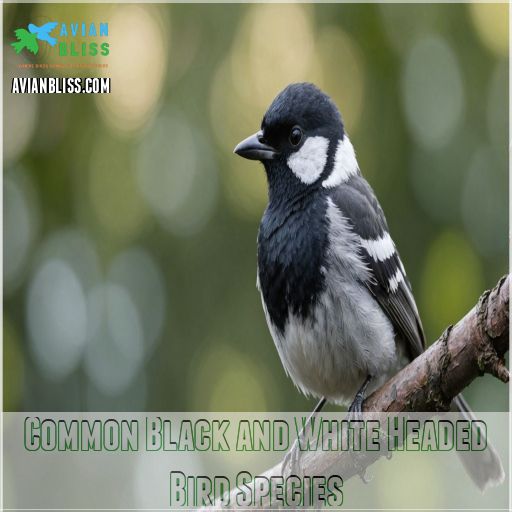
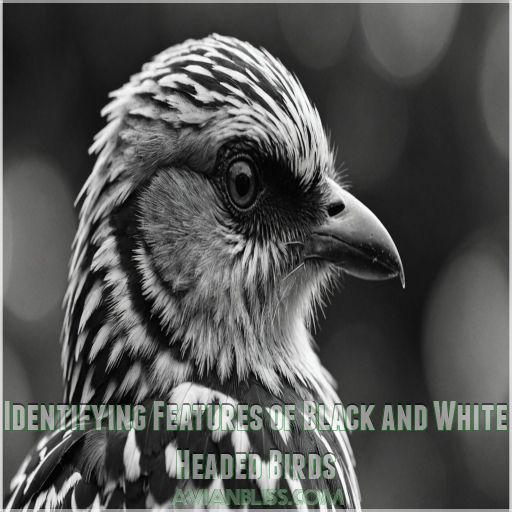


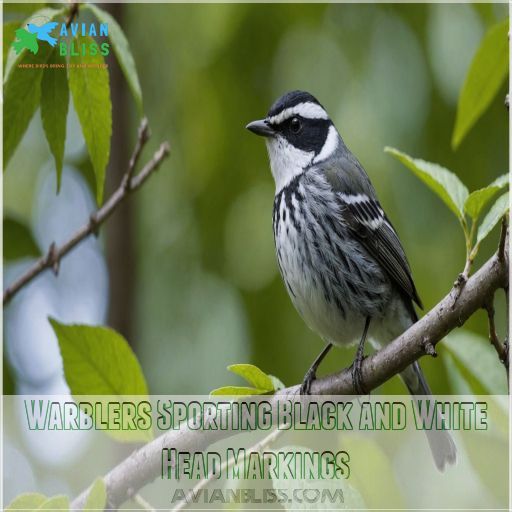

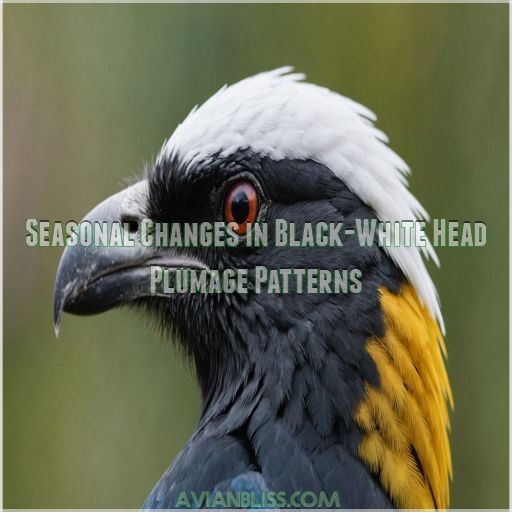
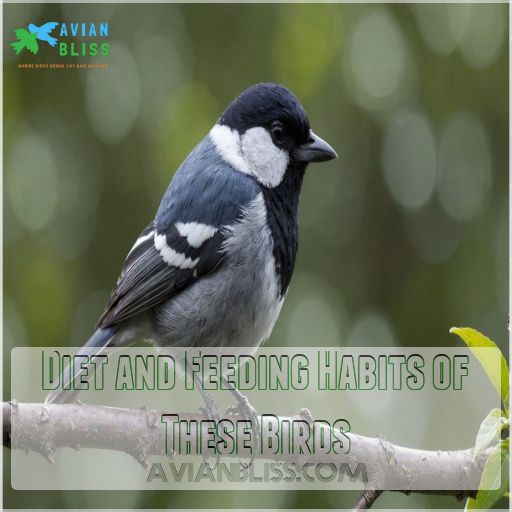
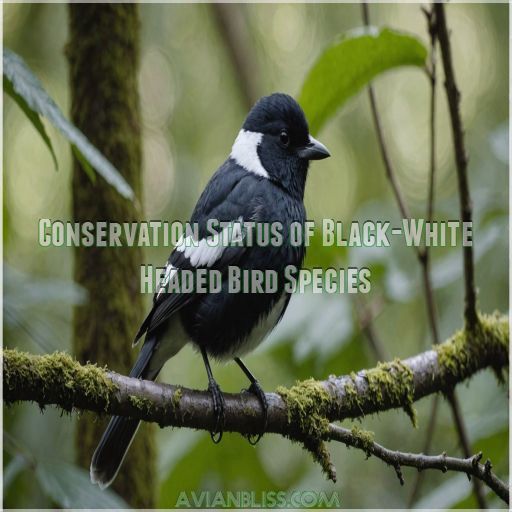

0 Comments